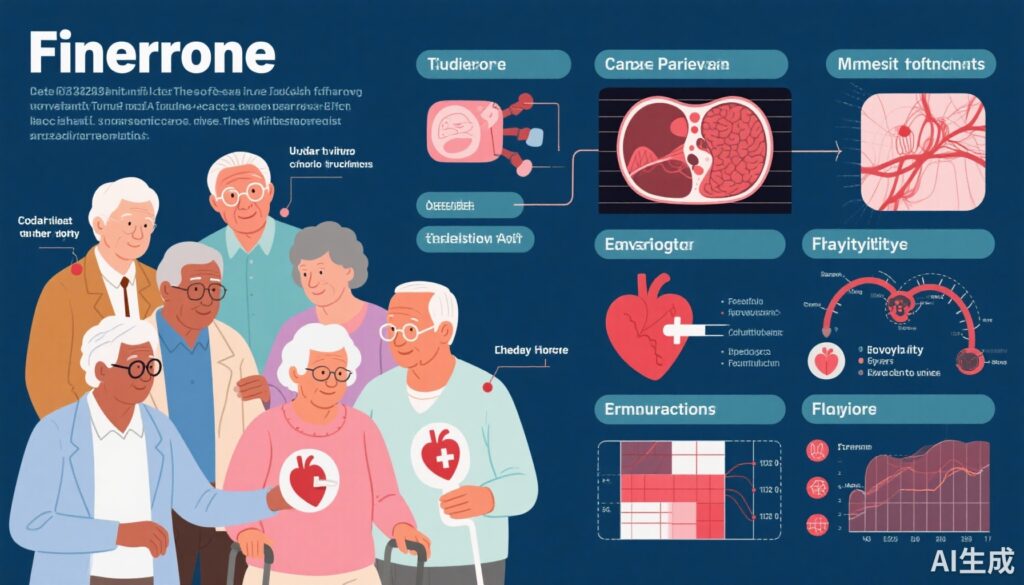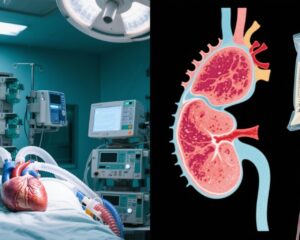Highlight
• Finerenone significantly reduces the risk of cardiovascular death and total worsening heart failure (HF) events in patients with HFmrEF and HFpEF.
• This benefit is consistent across frailty classes, including the most frail patients.
• Frailty status does not modify the safety profile of finerenone regarding hypotension, renal function, or electrolyte disturbances.
• Clinicians should consider finerenone therapy irrespective of patients’ frailty levels to optimize HF outcomes.
Study Background and Disease Burden
Heart failure with preserved ejection fraction (HFpEF) and mildly reduced ejection fraction (HFmrEF) represent substantial and growing subsets of patients with heart failure (HF). These conditions are associated with significant morbidity and mortality and constitute an unmet clinical need regarding effective treatments. Frailty, characterized by decreased physiological reserve and increased vulnerability to adverse outcomes, frequently coexists in patients with HF, further complicating management. Frail patients are often excluded or underrepresented in clinical trials, and clinicians may hesitate to prescribe novel therapies due to concerns about adverse events or limited efficacy. Understanding whether therapeutic benefits extend equally to frail patients remains critical to improving care and reducing health disparities.
Study Design
This analysis is a prespecified secondary examination within the Finerenone Trial to Investigate Efficacy and Safety Superior to Placebo in Patients With Heart Failure (FINEARTS-HF), a phase 3, double-blind, randomized, placebo-controlled clinical trial. Conducted at 653 clinical sites across 37 countries, the trial enrolled 6001 patients with heart failure classified as New York Heart Association (NYHA) functional class II-IV, left ventricular ejection fraction (LVEF) ≥40%, evidence of structural heart disease, and elevated natriuretic peptide levels. Patients were randomized from September 2020 to January 2023 to receive once-daily finerenone or placebo in addition to standard HF therapy. Frailty was quantified using the Rockwood cumulative deficit approach, producing a frailty index (FI) that stratified patients into three classes: class I (FI ≤ 0.210, not frail), class II (FI 0.211–0.310, more frail), and class III (FI ≥ 0.311, most frail). The primary composite endpoint was cardiovascular death plus total worsening HF events (hospitalizations and urgent visits).
Key Findings
Frailty Classification and Baseline Risk:
Among 5952 patients with calculable frailty index, the distribution was: 26.7% class I (not frail), 36.0% class II (more frail), and 37.3% class III (most frail). Frailer patients had progressively higher risk of the primary composite outcome versus non-frail counterparts, with unadjusted rate ratios (RR) of 1.88 (95% CI, 1.54–2.28) for class II and 3.86 (95% CI, 3.22–4.64) for class III, highlighting frailty as a potent prognostic factor.
Effect of Finerenone on Primary Outcome:
The overall effect of finerenone in reducing the composite endpoint was confirmed; however, the interaction analysis demonstrated no statistically significant difference in treatment effect across frailty classes (P for interaction = .77). Specifically, rate ratios for the primary outcome comparing finerenone versus placebo were 1.07 (95% CI, 0.77–1.49) in class I frailty, 0.66 (95% CI, 0.52–0.83) in class II, and 0.91 (95% CI, 0.76–1.07) in class III. These findings indicate consistent efficacy even in the most frail patients.
Secondary Outcomes and Symptom Improvement:
Frailty status did not modify finerenone’s effects on the individual components of the primary endpoint (cardiovascular death and total worsening HF events) or all-cause mortality. Furthermore, finerenone significantly improved symptoms assessed by the Kansas City Cardiomyopathy Questionnaire total symptom score, with benefit observed independent of frailty class.
Safety and Tolerability:
The safety profile of finerenone was consistent regardless of frailty status. Rates of adverse events such as hypotension, elevated serum creatinine, hyperkalemia, and hypokalemia did not differ significantly between finerenone and placebo groups within any frailty class. This suggests that concerns about increased adverse events should not preclude finerenone use in frail HF patients.
Expert Commentary
Frailty has traditionally been a challenge in HF management due to limited data on treatment efficacy and safety in this vulnerable population. The robust methodology of using a prespecified frailty index analysis in a large, multinational randomized trial like FINEARTS-HF provides high confidence in these findings. The results corroborate that finerenone, a selective nonsteroidal mineralocorticoid receptor antagonist, delivers clinical benefit without undue safety risks across frailty spectrums in patients with preserved and mildly reduced ejection fraction.
These findings align with emerging evidence that frailty should not be a barrier to evidence-based HF therapies. Mechanistically, finerenone’s anti-inflammatory and antifibrotic effects may target pathways relevant to frailty and HF progression. Critically, inclusion of frail patients enhances the generalizability of these results and supports broader implementation.
Potential study limitations include the secondary analysis nature and residual confounding, though stratification by a validated frailty index strengthens the conclusions. Future studies may explore longitudinal frailty dynamics and real-world effectiveness.
Conclusion
The prespecified FINEARTS-HF analysis robustly demonstrates that finerenone reduces cardiovascular death and worsening HF events while improving symptoms in patients with HFmrEF or HFpEF, irrespective of frailty status. Safety outcomes remain consistent across frailty strata. Given the high burden and vulnerability of frail patients with HF, these data support wider adoption of finerenone therapy without exclusion based on frailty. These findings underscore the need for clinicians to systematically assess frailty but not withhold guideline-recommended therapies owing to frailty alone. Continued research is warranted to optimize comprehensive care integrating frailty assessment and targeted HF treatments.
References
1. Butt JH, Jhund PS, Henderson AD, et al. Finerenone According to Frailty in Heart Failure: A Prespecified Analysis of the FINEARTS-HF Randomized Clinical Trial. JAMA Cardiol. 2025;10(8):829-840. doi:10.1001/jamacardio.2025.1775.
2. Rockwood K, Mitnitski A. Frailty in relation to the accumulation of deficits. J Gerontol A Biol Sci Med Sci. 2007;62(7):722-727. doi:10.1093/gerona/62.7.722.
3. McMurray JJV, Solomon SD, Inzucchi SE, et al. Dapagliflozin in patients with heart failure and reduced ejection fraction. N Engl J Med. 2019;381(21):1995-2008. doi:10.1056/NEJMoa1911303.
4. Sharma A, Jhund PS. Frailty and heart failure: what is the connection? Eur Heart J Suppl. 2021;23(Suppl C):C25-C29. doi:10.1093/eurheartj/suab098.



